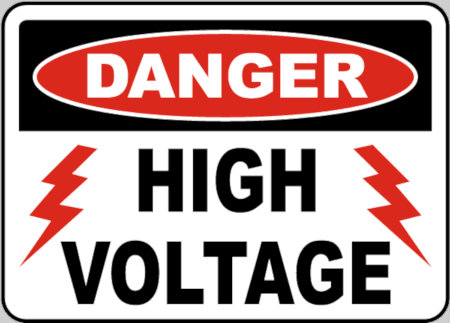Stun Gun Myths

Imagine being jolted by a powerful wave of electricity. Sounds dramatic, right? This is part of the hard-hitting reality associated with stun guns which have been villainized by popular culture and misunderstood by many. In today’s post, we're electing to channel truth over shock value as we debunk the most common myths surrounding stun guns. Strap in and brace yourselves for a thrilling discussion where we separate fact from fiction, powering up an enlightened perspective on these often misunderstood self-defense devices.
In our article addressing stun gun myths, we debunk several common misconceptions. One prevailing myth is that high voltage stun guns are more powerful; however, it's actually the amperage that determines effectiveness. Another myth is that simply touching someone with a stun gun will incapacitate them, whereas in reality, sustained contact of 3-5 seconds in large muscle groups is necessary. We provide authoritative answers to these and other widely believed myths to help you understand the truth about stun guns.
Debunked Myths about Stun Guns
Stun guns, also known as electroshock weapons, have been a topic of debate and speculation for years. Misconceptions surrounding their effectiveness and functionality often lead to confusion. In this section, we will shed light on some of the most common myths about stun guns and separate fact from fiction.
Myth: High Voltage Equals More Power
One widely believed myth is that a higher voltage in stun guns equates to greater power and effectiveness. However, this is simply not true. Voltage alone does not determine the strength or incapacitating power of a stun gun. It's actually the amperage, or the flow of electrical current, that poses a threat.

To illustrate this point, let's consider an analogy: Imagine two cups containing water. Cup A has 1000 volts of electricity running through it, while Cup B has only 100 volts. Despite the significant voltage difference between the two cups, if you were to touch both simultaneously, you would still feel a shock from both cups due to the current flowing through your body. The same principle applies to stun guns.
In reality, reputable stun gun brands like Stun Master and Police Force focus on delivering sufficient amperage rather than excessively high voltages. This ensures that when deployed correctly and for an adequate duration, the electrical charge can disrupt voluntary muscular control without causing long-term harm.
It's important to remember that stun guns are designed primarily for close-contact encounters and self-defense purposes; they are not lethal weapons meant to inflict serious harm or incapacitate instantly.
Myth: Brief Touch Leads to Instant Incapacitation
One of the most common misconceptions about stun guns is that a brief touch with the device leads to instant incapacitation. While it's true that even a slight touch from a stun gun can cause someone to jerk back, it does not immediately render them completely incapacitated. Stun guns work by delivering an electric shock to disrupt the body's muscle control and impair voluntary movement temporarily. The effectiveness of a stun gun depends on how long it is applied to the target and where on the body it is used.
It's important to note that for a stun gun to be effective, it needs to be held against the target for an extended period of time, typically 3 to 5 seconds, and applied to large muscle groups such as the torso or thighs. This allows the electrical current to penetrate deeper into the muscles, causing more significant disruption and temporary immobilization.
Using an analogy, think of a stun gun's effectiveness like turning off a light switch. A quick tap on the switch may cause a brief flicker or momentary interruption, but it won't keep the lights off for long. However, pressing and holding down the switch for several seconds will ensure a sustained period of darkness.
Stun Guns versus TASERs
There is often confusion between stun guns and TASERs, with many people mistakenly believing they are the same thing. However, there are crucial differences between these two devices in terms of functionality and effect.
A stun gun is a handheld device that requires direct contact with the target's body to deliver an electric shock. As we discussed earlier, its primary purpose is to temporarily disrupt muscle control and immobilize the individual through pain compliance.
On the other hand, a TASER operates differently. It uses compressed nitrogen propulsion to shoot out two tethered electrodes connected by wires. These electrodes attach themselves into the target's clothing or skin from a distance, typically up to 15 feet. Once the electrodes make contact, the TASER delivers an electrical pulse that disrupts the target's neuromuscular system, causing temporary incapacitation.
The key distinction between stun guns and TASERs lies in the mechanism of incapacitation. While stun guns rely on pain compliance through direct contact, TASERs use neuromuscular incapacitation by interfering with the body's ability to control muscle movements. TASERs allow law enforcement officers to immobilize subjects from a distance, providing them with more control over potentially dangerous situations.
It is crucial to note that both stun guns and TASERs have their own limitations and considerations. Understanding these differences helps individuals make informed decisions about self-defense options based on their specific needs and circumstances.
Understanding the Crucial Differences
When it comes to stun guns, it is important to distinguish between various devices to understand their functionality and intended use. One common misconception is that stun guns and TASERs are the same thing. In reality, they are different devices that rely on different mechanisms for incapacitating potential threats.
Stun guns operate by delivering a high-voltage electric shock when in direct contact with the target's body. They are designed to cause pain compliance, temporarily disabling an attacker through intense muscle contractions. On the other hand, TASERs utilize neuromuscular incapacitation by shooting projectiles called probes that attach to the target from a distance and deliver electrical pulses. This results in involuntary muscle spasms and renders the target unable to continue their aggressive actions.
Understanding these crucial differences helps in making informed decisions about which device is best suited for individual needs and personal safety. Both stun guns and TASERs have their advantages and limitations, which we will explore further in this article.
Now that we have clarified the distinctions between stun guns and TASERs, let us delve into the practical effectiveness of stun guns.
- It is important to understand the differences between stun guns and TASERs, as they operate using different mechanisms for incapacitating potential threats. Stun guns deliver a high-voltage shock upon direct contact with the target's body, causing intense muscle contractions and pain compliance. On the other hand, TASERs shoot probes from a distance, delivering electrical pulses that result in involuntary muscle spasms and render the target unable to continue aggressive actions. Knowing these differences allows individuals to make informed decisions about which device is best suited for their personal safety needs.
Practical Effectiveness of Stun Guns
Stun guns can be valuable self-defense tools when used appropriately and in the right circumstances. While they may not be foolproof, they offer several benefits worth considering. It is crucial, however, to separate fact from exaggerated claims to have a realistic understanding of their practical effectiveness.
Firstly, one common myth suggests that simply touching someone with a stun gun will instantly incapacitate them. The reality is that while a slight touch or grazing might cause an involuntary jerk back reaction from the recipient due to the discomfort caused, it generally takes holding the device against large muscle groups for 3-5 seconds to achieve optimal effectiveness.
Secondly, some may question whether using a stun gun poses a risk of shock or electrocution to the user. Rest assured, the energy delivered by the stun gun is primarily directed towards the target's muscles, and there is minimal risk of electricity jumping back to the user.
It is also important to note that stun guns are more effective when used in close-contact situations. Their electrical shock spreads less efficiently through heavy clothing or multiple layers, which may reduce their effectiveness in certain scenarios.
Furthermore, it is worth mentioning that the practical effectiveness of a stun gun can vary depending on various factors such as the size and health condition of the attacker, as well as the voltage and amperage of the device itself. It is crucial to choose a reputable brand with reliable products that deliver sufficient amperage for an effective incapacitation while adhering to safety standards.
While some critics argue that stun guns are not effective weapons for self-defense purposes, proponents highlight their usefulness in specific situations where physical force escalation may not be necessary or desired. For instance, a stun gun can provide a non-lethal means of deterring attackers, buying time to escape potentially dangerous encounters.
Ultimately, understanding the practical effectiveness of stun guns requires informed decision-making based on personal circumstances, preferences, and knowledge of their limitations. It is recommended to research reputable brands and consult with self-defense experts or local laws to make an educated choice about incorporating a stun gun into your personal safety strategy.
Now that we have explored the practical effectiveness of stun guns, let us delve deeper into their limitations and address common misconceptions.
The Reality of Stun Gun Limitations
Stun guns have gained immense popularity as a non-lethal self-defense tool in recent years. While they can be effective, it's important to understand their limitations to make informed decisions about personal safety. Let's debunk some common myths and separate fact from fiction when it comes to stun guns.
Firstly, there is a misconception that stun guns are foolproof and will incapacitate an attacker instantly. In reality, the effectiveness of a stun gun depends on various factors such as the duration of contact, the location of the strike, and the individual's pain tolerance. While a well-placed shock can immobilize an assailant temporarily, it may not always guarantee immediate incapacitation or complete control over the situation.
Another myth is that stun guns only affect muscular movement and won't cause any long-term harm. While it's true that stun guns primarily target the neuromuscular system, delivering a high-voltage shock to interrupt normal electrical signals in the body, there can be associated risks and potential injuries. The intensity and duration of the shock can vary among different stun gun models, and excessive use or prolonged contact can lead to more severe consequences like muscle strains, burns, or even cardiac complications for individuals with pre-existing conditions.
It's also important to dispel the notion that stun guns have an unlimited range. Unlike tasers that can shoot metal prongs for remote contact, stun guns require direct contact with an assailant. This means that you need to be within arm's reach for them to be effective. It's essential to consider personal safety and proximity when relying on a stun gun for self-defense.
Lastly, stun guns are commonly misperceived as a replacement for conventional firearms in terms of effectiveness. While they provide an alternative deterrent, it's crucial to recognize that they may not always be suitable or sufficient for certain threatening situations. Understanding these limitations helps avoid creating a false sense of security and encourages individuals to explore the best combination of self-defense measures for their specific needs.
Now that we have a clearer understanding of the realities and limitations surrounding stun guns, let's shift our focus to smart shopping: exploring reputable stun gun brands and essential safety precautions to consider.
Smart Shopping: Stun Gun Brands and Safety Precautions
When it comes to purchasing a stun gun, it's crucial to invest in a high-quality product from a reputable brand to ensure reliability and effectiveness. Here are some key factors to consider when engaging in smart shopping for stun guns:
1. Research Trusted Stun Gun Brands: Spend time researching reliable manufacturers that prioritize safety and quality. Look for brands that have positive customer reviews, provide extensive product information, and offer warranties or guarantees on their devices. Some well-known stun gun brands include Runt and Streetwise Lifeguard.
2. Evaluate Voltage and Features: Consider the voltage output of the stun gun you're considering, as higher voltages generally deliver more effective shocks. Additionally, explore additional features like built-in flashlights or alarms that can enhance the device's utility in emergency situations.
3. Legal Considerations: Familiarize yourself with local laws and regulations regarding stun guns as they can vary from one jurisdiction to another. Ensure that owning a stun gun is legal in your area and abide by any restrictions or requirements imposed by authorities.
4. Training and Certification: While not mandatory in all places, undertaking self-defense classes or receiving training on proper stun gun usage adds an extra layer of safety knowledge. Look for courses or instructors who specialize in teaching self-defense techniques specifically tailored for stun guns.
Tara, for instance, lives in a state where owning a stun gun is legal but requires certification to own one. She takes part in a certified training program conducted by self-defense experts, which not only hones her skills but also educates her on the responsibilities and ethical considerations related to using stun guns.
Jordan, on the other hand, prioritizes reputation and brand reliability. After extensive research and reading customer reviews, he selects a stun gun from TBOTECH Safety & Securty, LLC due to its positive reputation for quality and longevity.
By taking into account these factors during your shopping process, you can make an informed decision and select a stun gun that aligns with your safety requirements and legal obligations.
Are all stun guns legal to use in every state?
No, stun gun laws vary by state in the United States. While some states allow the unrestricted use and possession of stun guns, others have specific regulations and restrictions in place. It's important for individuals to familiarize themselves with their state's laws regarding stun guns to ensure compliance and avoid legal consequences.
Are stun guns effective for self-defense against multiple attackers?
Stun guns can be effective for self-defense against multiple attackers, thanks to their ability to temporarily incapacitate an assailant. While there aren't specific statistics available on stun gun use against multiple attackers, the strong electrical shock delivered by stun guns can provide crucial moments to escape or seek help. However, it's important to remember that stun guns have limited range and require close proximity to the attacker, making awareness, strategy, and if possible, retreat the key elements to ensure personal safety in such situations.
What safety precautions should be taken when using a stun gun?
When using a stun gun, it's crucial to prioritize safety. Firstly, always read and understand the instruction manual provided by the manufacturer. Secondly, ensure that the stun gun is properly charged before use. Additionally, only use the stun gun as a last resort for self-defense purposes in potentially dangerous situations. Aim for the torso to maximize effectiveness but avoid targeting sensitive areas such as the head or groin. Lastly, keep in mind that stun guns are not foolproof devices and should not be solely relied upon for personal safety. According to a study conducted by the National Institute of Justice, stun guns have an average success rate of 86% in disabling attackers when used appropriately.
Can stun guns cause permanent damage or injury?
Yes, stun guns can cause permanent damage or injury under certain circumstances. While the primary goal of stun guns is to incapacitate an attacker temporarily, excessive and prolonged use can lead to more severe consequences. High-voltage shocks have the potential to cause cardiac issues, neurological damage, and even death in some cases. According to a study conducted by the American Journal of Emergency Medicine, around 1% of stun gun-related injuries result in permanent disabilities. It is crucial to use stun guns responsibly and as a last resort when personal safety is at risk.
Do stun guns really have a long-lasting effect on the attacker?
Stun guns do not have a long-lasting effect on the attacker. Despite popular belief, stun guns only deliver a temporary electric shock to immobilize the target temporarily. The effects typically last for a few seconds to a few minutes, giving the victim an opportunity to escape or seek help. Studies show that stun guns do not cause any long-term physical harm or permanent damage to the attacker's body. However, it is important to note that individual reactions might vary, and prolonged or repeated use could potentially lead to more severe consequences.
Add your comment now!
Post Comment




